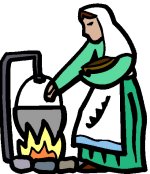
Worksheets and No Prep Teaching Resources
Reading Comprehension Worksheets
Colonial America (1492-1776)

Colonial America (1492-1776)
 Worksheets and No Prep Teaching Resources Reading Comprehension Worksheets Colonial America (1492-1776) |
 Colonial America (1492-1776) |
| edHelper's suggested reading level: | grades 3 to 5 | |
| Flesch-Kincaid grade level: | 4.3 |
|
What's for Lunch?
By Sharon Fabian |

|
 1 The colonists planned to raise their own food. They brought seeds to America. With seeds, they could plant vegetable gardens. They brought farm animals, too. They planned to raise crops and animals each year.
1 The colonists planned to raise their own food. They brought seeds to America. With seeds, they could plant vegetable gardens. They brought farm animals, too. They planned to raise crops and animals each year. |
Create Weekly Reading Books
Prepare for an entire week at once! |
| Leave your feedback on What's for Lunch? (use this link if you found an error in the story) |
 |
Colonial America (1492-1776)
|
 |
United States
|
|
|
 | Fifty States Theme Unit |
 |
Document Based Activities |